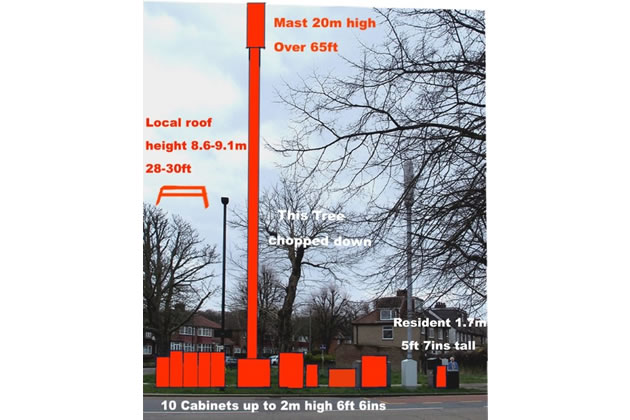Plan for 20 Metre High Mast in Greenford Blocked
Planning inspector dismisses appeal after Ealing Council refused permission

Residents of Whitton Drive and Whitton Avenue East in Greenford are celebrating after a proposal to build a 20 metre high telecommunications mast was blocked.
The applicant was proposing to remove an existing mast at the site and replace it with the new mast with 5G capability and cabinet units and bollards at the base as well as removing a tree.
Ealing Council had already refused permission last August for the mast to be built at the junction of the two roads but the applicant appealed and the case was referred to the Planning Inspectorate.
The inspectors concurred with the council planners’ decision and dismissed the appeal on the basis of the appearance of the mast. It is thought that this could set a significant precedent as most roadside masts had previously been given approval.
The inspectors report states, “The proposed monopole would rise significantly above the existing street trees and would be roughly twice as high as the surrounding two storey dwellings. Existing vertical structures nearby, such as street lights and electricity poles would be dwarfed by the height of the monopole and appear disproportionate relative to its dominant scale. The prominence of the monopole would be accentuated by its thickness while the top half of the installation would be conspicuous by the exposed antennae giving it a top-heavy appearance above the adjacent tree canopies.”
It was concluded that this would be “a jarring and incongruous presence on the verdant setting of the landscaped corridor and the surrounding built environment” and “would appear unacceptably imposing from nearby residential properties and cause harm to their outlook.”
The report acknowledged the need for the build out for telecommunications infrastructure but said that the applicant had not shown they had given significant consideration to alternative sites.
5G operates across multiple spectrums and therefore requires additional antennas and new equipment cabinets. The signals that are broadcast are more prone to the shadowing effect of adjacent buildings or structures, and also the effect of tree canopies reducing the broadcast range and effectiveness of the antennas. Consequently, the height of the 5G antennas needs to be raised meaning such high masts, dubbed ‘monster masts’ by objectors will become more common. The higher frequencies that 5G will use can provide more bandwidth and thus greater capacity but the signal will not travel as far as those of previous generations. This will mean that more of these masts will need to be built than were needed for previous generations of mobile technology.
Like Reading Articles Like This? Help Us Produce More This site remains committed to providing local community news and public interest journalism. Articles such as the one above are integral to what we do. We aim to feature as much as possible on local societies, charities based in the area, fundraising efforts by residents, community-based initiatives and even helping people find missing pets. We’ve always done that and won’t be changing, in fact we’d like to do more. However, the readership that these stories generates is often below that needed to cover the cost of producing them. Our financial resources are limited and the local media environment is intensely competitive so there is a constraint on what we can do. We are therefore asking our readers to consider offering financial support to these efforts. Any money given will help support community and public interest news and the expansion of our coverage in this area. A suggested monthly payment is £8 but we would be grateful for any amount for instance if you think this site offers the equivalent value of a subscription to a daily printed newspaper you may wish to consider £20 per month. If neither of these amounts is suitable for you then contact info@neighbournet.com and we can set up an alternative. All payments are made through a secure web site. One-off donations are also appreciated. Choose The Amount You Wish To Contribute. If you do support us in this way we’d be interested to hear what kind of articles you would like to see more of on the site – send your suggestions to the editor. For businesses we offer the chance to be a corporate sponsor of community content on the site. For £30 plus VAT per month you will be the designated sponsor of at least one article a month with your logo appearing if supplied. If there is a specific community group or initiative you’d like to support we can make sure your sponsorship is featured on related content for a one off payment of £50 plus VAT. All payments are made through a secure web site. |
October 8, 2020